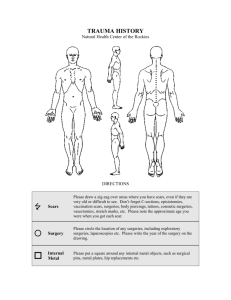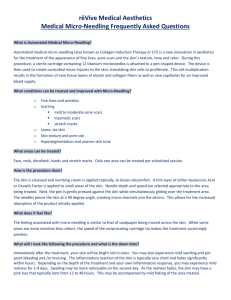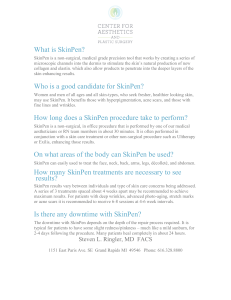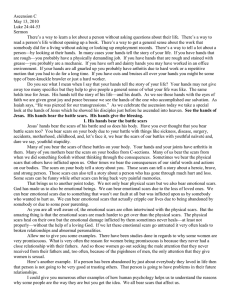Scars are a powerful metaphor for being profoundly impacted by a
advertisement
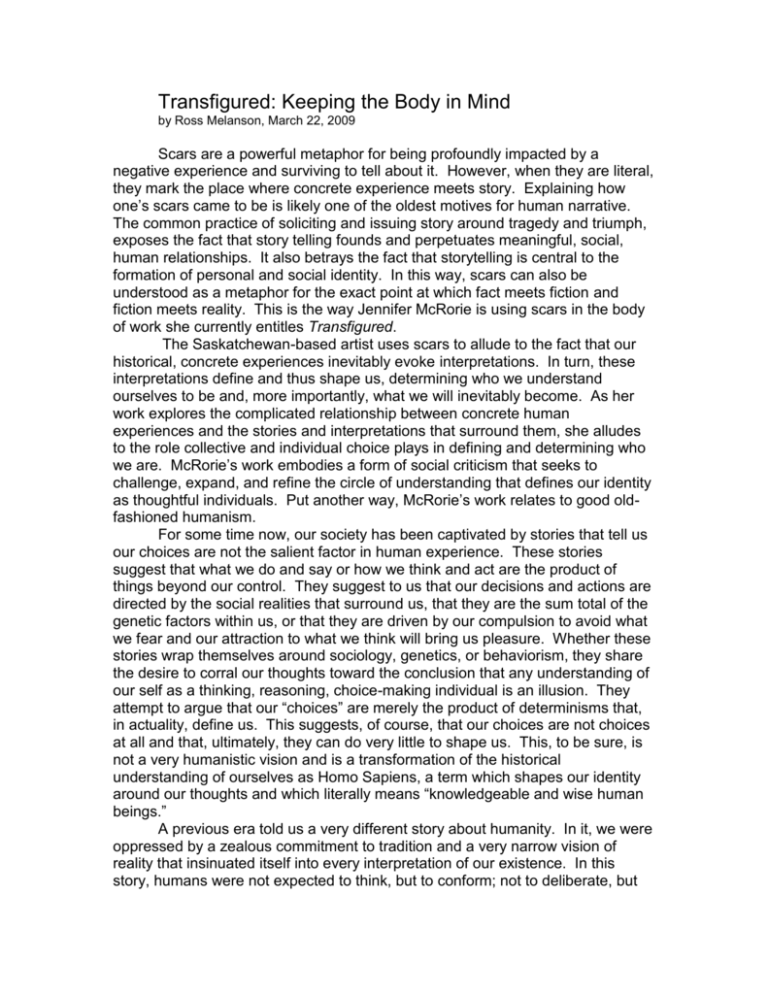
Transfigured: Keeping the Body in Mind by Ross Melanson, March 22, 2009 Scars are a powerful metaphor for being profoundly impacted by a negative experience and surviving to tell about it. However, when they are literal, they mark the place where concrete experience meets story. Explaining how one’s scars came to be is likely one of the oldest motives for human narrative. The common practice of soliciting and issuing story around tragedy and triumph, exposes the fact that story telling founds and perpetuates meaningful, social, human relationships. It also betrays the fact that storytelling is central to the formation of personal and social identity. In this way, scars can also be understood as a metaphor for the exact point at which fact meets fiction and fiction meets reality. This is the way Jennifer McRorie is using scars in the body of work she currently entitles Transfigured. The Saskatchewan-based artist uses scars to allude to the fact that our historical, concrete experiences inevitably evoke interpretations. In turn, these interpretations define and thus shape us, determining who we understand ourselves to be and, more importantly, what we will inevitably become. As her work explores the complicated relationship between concrete human experiences and the stories and interpretations that surround them, she alludes to the role collective and individual choice plays in defining and determining who we are. McRorie’s work embodies a form of social criticism that seeks to challenge, expand, and refine the circle of understanding that defines our identity as thoughtful individuals. Put another way, McRorie’s work relates to good oldfashioned humanism. For some time now, our society has been captivated by stories that tell us our choices are not the salient factor in human experience. These stories suggest that what we do and say or how we think and act are the product of things beyond our control. They suggest to us that our decisions and actions are directed by the social realities that surround us, that they are the sum total of the genetic factors within us, or that they are driven by our compulsion to avoid what we fear and our attraction to what we think will bring us pleasure. Whether these stories wrap themselves around sociology, genetics, or behaviorism, they share the desire to corral our thoughts toward the conclusion that any understanding of our self as a thinking, reasoning, choice-making individual is an illusion. They attempt to argue that our “choices” are merely the product of determinisms that, in actuality, define us. This suggests, of course, that our choices are not choices at all and that, ultimately, they can do very little to shape us. This, to be sure, is not a very humanistic vision and is a transformation of the historical understanding of ourselves as Homo Sapiens, a term which shapes our identity around our thoughts and which literally means “knowledgeable and wise human beings.” A previous era told us a very different story about humanity. In it, we were oppressed by a zealous commitment to tradition and a very narrow vision of reality that insinuated itself into every interpretation of our existence. In this story, humans were not expected to think, but to conform; not to deliberate, but obey. In the dawn of the Reformation, Renaissance, and the Age of Reason, a flood of light washed all this darkness away and set us free to think, reason, and choose for ourselves. This story birthed a very humanistic, democratic and optimistic vision that made us all peers, in that each an every one of us possessed the flower of creation, a mind, and the potential ability to use it for the common good. McRorie’s scars seek to capture many things. Primarily, they suggest a moment in time where circumstance, in the form of calamity, befalls an individual and leaves its mark. However, just as a scar denotes the passage of time and the evolution from trauma toward healing, her images allude to the process of thinking that follows all of our experiences. They suggest the deliberation, consideration, and evaluation within our thinking that seeks to interpret the significance of the experiences that befall us. The work in this exhibition is fraught with ambiguity, which is to say, it is marked by an aesthetic of paradox. Every moment that considers this work, discovers a new and apparent contradiction. The images are realist in nature and thus seem concrete and representational. However, they are abstracted in the sense that the images provide no real locative context from which to interpret them. We have no way of knowing where these scars are located on the body nor where that body containing the scars happens to be. In this sense, we are left to wonder how big a deal these scars are. These images suggest a narrative in that we know that scars are the product of some physical trauma. However, we have no real details that fill in the specifics of that suggested narrative. In this sense, we are left to wonder how much empathy and compassion the images are demanding of us. Their scale brings us into intimate proximity with the subject and provides us with excessive detail regarding one singular aspect of that person. However, the decontextualization, combined with the very personal indication of tragedy and suffering, heightens a sense of objectification. In this sense, we are left to wonder whether we are to be ponderous and abstract or engaged and sensual. These are but a few of the resident ambiguities of the images. It is this factor of McRorie’s work that is the true genius of it. The paradoxical nature of these images is a gateway to recognizing the ultimate subject of them – open-ended thinking, the human mind pondering and not coming to rest. The questions which McRorie’s dialectical images evoke relate strongly to the very real questions of meaning and significance which naturally arise from all concrete human experiences, especially those which emit from traumatic situations. The dialectical nature of the images confounds the viewer and thus accurately captures the feeling or sensation of being in the throws of deciding, considering, questioning, and evaluating. If there is any beauty in these images, it is found in the human mind thinking about them, trying to perceive an understanding that is presently eluding it. It is, in this sense, that McRorie’s vision interfaces with the very kind of humanism that pervaded both the Reformation and the Renessaince, set the horizon for the Age of Reason, and laid the foundations of modern democratic thought. Throughout all these eras, there was a captivation with the nature of the mind and a growing reverence for the significance of human self-consciousness, the ability to consider and appraise one’s own thoughts. It was the human mind, these old worthies believed, that attached human beings to something beyond themselves and made humans something significantly more than mere bodies and ordinary beings. In differing ways, they all suggested that the workings of the mind compelled individuals to rise above what their historical circumstances dictated to them and compelled them to create a significantly different vision of reality. In other words, they believed that the mind was an agent of human and social transformation. Through her association with this kind of perspective, McRorie casts a subtle but critical eye on many of the contemporary stories that tell us that our choices and considerations are nothing more than manifestations of sociology, biology, or behaviorism. These views, to be sure, minimize the human mind and make it nothing more than an extension of mere matter shaped by the views of other people, genes, or psychological impulses. McRorie’s aesthetics of paradox reengages the viewer with the concept of the mind freed from dogma. With this aesthetic, she reminds us that thought is a process leading not to certain conclusion but further, deepened, and more nuanced thought with the latter being closer to reality than the former. In this, it is driven by the very humanist motive of emancipating us from the very confining interpretations of our recent past, interpretations that have scarred us to be sure. Like that of her humanist forebears, McRorie’s body of work is best seen as an exploration that attempts to discover what is fundamentally human about us. Her work seeks to convey the reality of what it means to be an actual person as opposed to a mere conceptual object or physical mass. While doing so, it presents ambiguous images that give the opportunity for the very human response of wondering what it all might mean.


